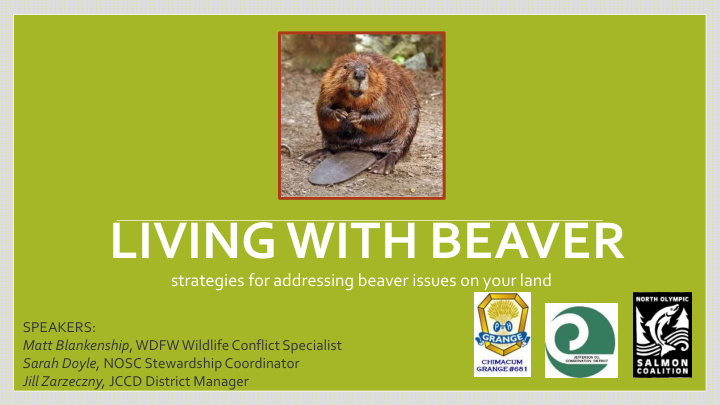



LIVING WITH BEAVER strategies for addressing beaver issues on your land SPEAKERS: Matt Blankenship , WDFW Wildlife Conflict Specialist Sarah Doyle, NOSC Stewardship Coordinator Jill Zarzeczny, JCCD District Manager
Strategies for Living With Beaver Overview of beaver habitat and behavior History of beaver in the Chimacum Watershed Beaver management and control techniques Available assistance to landowners with beaver
Life as a Beaver Ginger Holser General description Behavior Habitat Needs water wood Preferred PNW species: alder, apple, birch, cherry, cottonwood, and willow
Nature’s Engineers
Beaver in the Chimacum Historic Presence A Changing Landscape Early 1900’s: Stream channelization and forest clearing Early 2000’s: Changing laws and buffer establishment Local Challenges Proximity to sensitive infrastructure and agricultural resources Poorly draining soils Reed canarygrass infestations What Are We Trying to Do? addressing undesirable impacts Maintain drainage long-term flood prevention
Beaver Management and Control addressing undesirable impacts Site planning Responding to beaver activities on your land Monitoring and maintenance Todd Spedding
Preventative Site Planning Suitable beaver habitat Reach has habitat characteristics to support beaver populations Potential impact to resources or infrastructure is minimal or can be mitigated Beaver Conservation Zone – Living with Beaver Zone – Nuisance Beaver Zone
Preventative Site Planning Designing riparian buffer projects with beaver in mind Reduce or eliminate most desirable tree or shrub species Protect newly planted trees where beaver are likely to inhabit Not Preferred (by Beaver) Species Beaver Resistant Species Cascara Willow spp. Sitka Spruce salmonberry Red elderberry Nootka rose Oregon ash Red-osier dogwood twinberry Douglas spirea Pacific ninebark Indian plum
Responding to Beaver Activity on Your Land Does it have Is beaver potential to dam NO cause causing YES damage in damage? NO the future? Can the Leave impacts be It NO or Repeat efforts are mitigated? Is beaver YES Alone NOT working Are beaver YES NO currently Notch out dam Monitor active in to non-problem What is and re- the area? level and the YES evaluate monitor Flooding impact? Tree harvesting Clogging Consider Is it or Stage trapping practical to problem? protect Stage Clogging trees? NO YES Install or Install or Consider maintain maintain trapping pond Install tree beaver and monitor deceiver and leveler and protection monitor monitor and monitor
“Living with Beaver” Strategies Resource Concern Suggested Best Management Practice Protection of Individual Trees Cylindrical Cages Textured Paint Mixture Protection of Planting Site Low Fences Species Selection and Placement Flood Prevention Beaver deceiver Flow leveler Flood Mitigation Dam notching Trapping
“Living with Beaver” Strategies Flood Prevention Beaver Deceivers Flow Levelers Reproduced courtesy of Mike Callahan, Owner Beaver Solutions LLC, “Working With Nature”
“Living with Beaver” Strategies Flood Mitigation Notching-out Dams: A short-term rapid response to prevent immediate damage from flooding A Hydraulic Project Approval (HPA) is required to remove or modify beaver dams. Existing Beaver Dam Modification HPA for the Chimacum Creek Watershed (exp. Sept 2019)
“Living with Beaver” Strategies Flood Mitigation Trapping • Furbearer Classified Species: Trapping Season from Nov.1 – Mar. 31 • Special permits are required for the use of body gripping traps (i.e padded and unpadded foot-hold traps, conibear type traps, and all snares. • The owner, the owner’s immediate family, an employee, or a tenant of property may shoot or trap a beaver on that property if a threat to crops exists (RCW 77.36.030). In such cases, no special trapping Bailey Beaver Live Trap permit is necessary for the use of live traps. However, a special (Wildlife Control Supplies 2015) trapping permit is required for the use of all traps other than live traps (RCW 77.15.192, 77.15.194; WAC 232-12-142). • It is currently unlawful to release beaver anywhere in the state, other then the property it was trapped on, without a special permit to do so.
Monitoring and Maintenance • A long-term relationship with beaver • Recruiting volunteers for the “Dam Busters”
Available Assistance • Jefferson County Conservation District • HPA application support • Technical Assistance – site planning , living with beaver evaluations, etc. • North Olympic Salmon Coalition • Technical Assistance – Site planning and adaptive management. • Wa. Department of Fish and Wildlife • Wildlife Control Operators licensed by WDFW. Please refer to wdfw.wa.gov to find WCO’s in your county. • In emergency situations (when an immediate threat to property or life exists), verbal approval from WDFW can be obtained for work necessary to solve the problem. A 24- hour hotline (360) 902-2537 is available for emergency calls during nonworking hours. During normal hours, contact Huffingtonpost.com your nearest WDFW Regional Office. • Contact WDFW Conflict Specialist for more information and strategies on preventing conflicts on your property.
Questions? Online Resources Beavers Northwest www.beaversnw.org Beaver Solutions www.beaversolutions.com Beavers: Wetlands and Wildlife www.beaversww.org WDFW: Living with Beaver wdfw.wa.gov/living/beavers.html
Recommend
More recommend